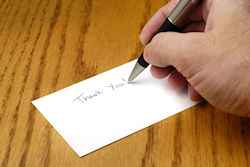What if I told you that you could make or break your advocacy practice by spending an additional 3-5 minutes after each client interface?
Yes – it could be that simple. Hold that thought as I explain…
All human beings like and appreciate acknowledgment – almost any kind of acknowledgement – for actions big and small.
- If you hold the door open for someone, you appreciate a thank-you, or even just a nod of the head from the person for whom you opened the door.
- If you give someone a gift, you want them to thank you. If you send it to them in the mail, you at least want to know it arrived.
- If you phone someone and must leave a message, then you appreciate it when they call back.
- If you invite friends for a meal, or just a cup of coffee, you want to know they enjoyed themselves and appreciated your efforts.
On the flip side:
- If you hold the door open for someone, but they don’t acknowledge you did so, you may think them to be rude.
- If you give someone a gift, and they don’t thank you, or even acknowledge it arrived in the mail, you consider not sending a gift the next time.
- If you leave a message for someone but they never call or write back, you wonder why they ignored you, and you may think less of them because of it.
- If you invite friends for a cup of coffee or a meal, you expect them to thank you. If they additionally thank you later by following up with an email or phone call (or, OMG, a handwritten note!) then your bond will be stronger, and you are more likely to invite them again sometime.
These examples should make it clear that beyond simple courtesy, appropriate follow-up to any client interface should be at the top of your list of things to do in order to grow and strengthen your business. This sort of follow-up takes very little time or effort, but can mean a huge difference in any relationship going forward. Intentional follow-up will always create or strengthen trust between you and your client or potential client.
Today’s post is a suggestion that you make such follow-up a formal part of your business. I’m not talking about a simple response to an email or just returning a phone call – that’s simple courtesy. I’m talking about a constant and consistent next step after each interface, as appropriate.
 Such a process and protocol would include tasks like these:
Such a process and protocol would include tasks like these:
In General
- Set the stage by letting people know when / how soon you will follow up. This includes adding such information to your voice mail or to an autoresponder on a web form or your email. “All calls will be returned within one business day.” or “I am out of the office today but will respond by end of day Tuesday.”
- Then, of course – adhere to your promises.
Follow up with Potential Clients
- Whenever possible, especially if you are at risk of hanging up with no contract promise, instead promise some sort of follow-up (a link to a page on your website, or a copy of a research report – anything your caller might consider useful). Then within a few hours, send an email to thank them for their time, provides the link or the attachment you promised, and offers to answer additional questions. (Don’t forget to ask for an email address during that phone call, of course.)
- If you don’t hear from them within 7-10 days, phone or email again. Use a friendly tone, ask if you can help them, or if they would like to spend a few more minutes on the phone.
 Follow up with Current or Past Clients
Follow up with Current or Past Clients
- Within 24 hours of any appointment you have attended, follow up with an email that outlines what took place (or attach a report), being sure to identify any and all next steps, and with a thank you for trusting you to be their advocate.
- Upon receipt of a payment, follow up with an email acknowledging receipt so they know it has arrived and you are ready for next steps.
- About two weeks after the completion of all your work with a client, follow up with a small gift as a way to thank them for business and to encourage them to refer new clients to you. (Small gift = a book, or a coffee shop gift card – something simple.)
- About three months after completion of all your work with a client, follow up with a phone call to see how they are doing, and to inquire if there’s more you can do to help them out.
- Birthdays and holidays are always good times to reach out, whether or not you are actively working with a client. A little remembrance goes a long way.
You may think of additional ways to follow up. These are only intended to get your creative juices flowing!
In none of these cases will you spend more than a few minutes of time. In every one of these cases, you will strengthen the trust you’ve built so far, and increase the likelihood of business (or more business) coming from that person.
How can you remember to do all this? How will you make the time? The answer is simple: make your follow-up easy and brief.
- Leave the last part of each day to write emails, thank you notes, or return phone calls from that day’s calls and emails. If you take care of them that day, they won’t slip by you.
- Add later follow-ups to your day planner or calendar. My first calendar entry for every day is the follow-up I need to do from something previous – last week or last month.
- Make up a series of email drafts that you can copy and paste as appropriate. Your follow-up email to every potential client can be the same email with the specific personal pieces swapped out for each. If you’ll be making phone calls, then make a brief outline of what needs to be covered for all of them, and refer to it as needed to keep your call on track.
I know, I know… I sound like your mother nagging you to write thank-you notes after your birthday!

But in this case, it’s not about Emily Post or Amy Vanderbilt. It’s about using the fine art of follow-up to attract and keep clients. The trust you create will help your business succeed.
MASTER LIST OF PRACTICE RESOURCES | LEARN ABOUT APHA MEMBERSHIP | REASONS PATIENTS NEED ADVOCATES





